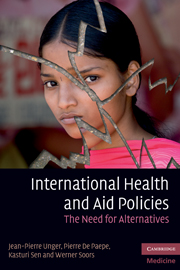Book contents
- Frontmatter
- Contents
- Preface
- Biographies
- Notices
- Acknowledgements
- List of abbreviations
- Reviews
- Introduction: Overview and purpose
- Section 1 Paradigms of international policies
- Section 2 The failure of the aid paradigm: poor disease control in developing countries
- Section 3 Impact of international health policies on access to health in middle-income countries: some experiences from Latin America
- 6 Costa Rica: achievements of a heterodox health policy
- 7 Colombia: in vivo test of health sector privatization in the developing world
- 8 Chile's neoliberal health reform: an assessment and a critique
- Section 4 Determinants and implications of new liberal health policies: the case of India, China and Lebanon
- Section 5 Principles for alternative, publicly oriented health care policies, planning, management and delivery
- Section 6 A public health, strategic toolkit to implement these alternatives
- Conclusions
- Glossary
- Index
- References
7 - Colombia: in vivo test of health sector privatization in the developing world
Published online by Cambridge University Press: 06 December 2010
- Frontmatter
- Contents
- Preface
- Biographies
- Notices
- Acknowledgements
- List of abbreviations
- Reviews
- Introduction: Overview and purpose
- Section 1 Paradigms of international policies
- Section 2 The failure of the aid paradigm: poor disease control in developing countries
- Section 3 Impact of international health policies on access to health in middle-income countries: some experiences from Latin America
- 6 Costa Rica: achievements of a heterodox health policy
- 7 Colombia: in vivo test of health sector privatization in the developing world
- 8 Chile's neoliberal health reform: an assessment and a critique
- Section 4 Determinants and implications of new liberal health policies: the case of India, China and Lebanon
- Section 5 Principles for alternative, publicly oriented health care policies, planning, management and delivery
- Section 6 A public health, strategic toolkit to implement these alternatives
- Conclusions
- Glossary
- Index
- References
Summary
Adapted from: De Groote T., De Paepe P., & Unger J.-P. (2005). Colombia: In vivo test of health sector privatization in the developing world. International Journal of Health Services, 35(1), pp. 125–41.
Introduction
The reform of the Colombian health sector in 1993 was founded on the internationally promoted paradigm of privatization of health care delivery. Taking into account the lack of empirical evidence for the applicability of this concept to developing countries and the documented experience of failures in other countries, Colombia tried to overcome these problems by a theoretically sound, but complex, model. Some 10 years after the implementation of ‘Law 100,’ a review of the literature shows that the proposed goals of universal coverage and equitable access to high-quality care have not been reached. Despite an explosion in costs and a considerable increase in public and private health expenditure, more than 40% of the population is still not covered by health insurance, and access to health care proves increasingly difficult. Furthermore, key health indicators and disease-control programmes have deteriorated. These findings confirm the results in other LMICs. The authors suggest the explanation lies in the inefficiency of contracting out; the weak economic, technical and political capacity of the Colombian Government for regulation and control; and the absence of real participation of the poor in decision making on (health) policies.
Privatization of health care delivery in developing countries received support from virtually all international aid agencies (European Commission, 2002; World Bank, 1997; World Health Organization, 2000).
- Type
- Chapter
- Information
- International Health and Aid PoliciesThe Need for Alternatives, pp. 83 - 96Publisher: Cambridge University PressPrint publication year: 2010



